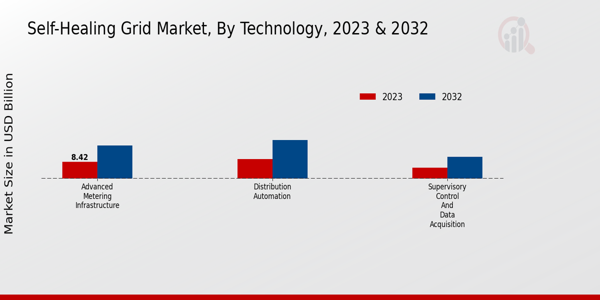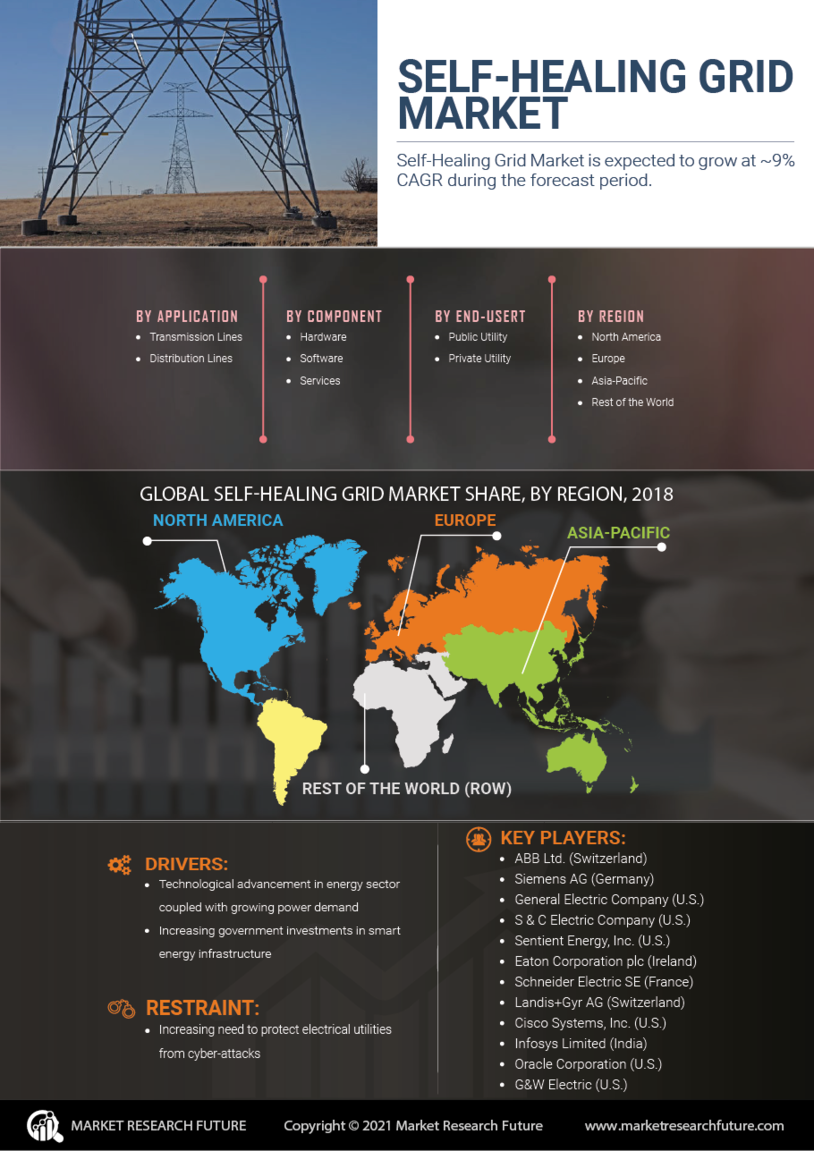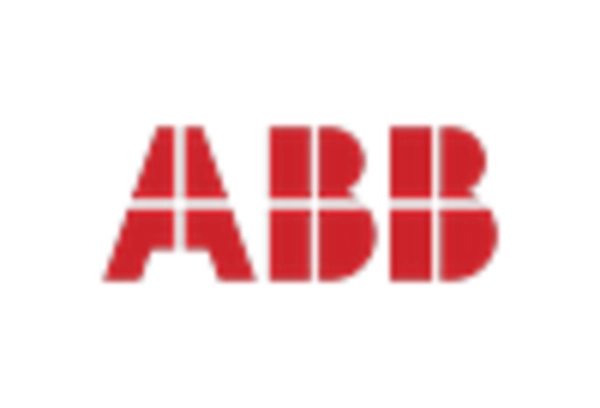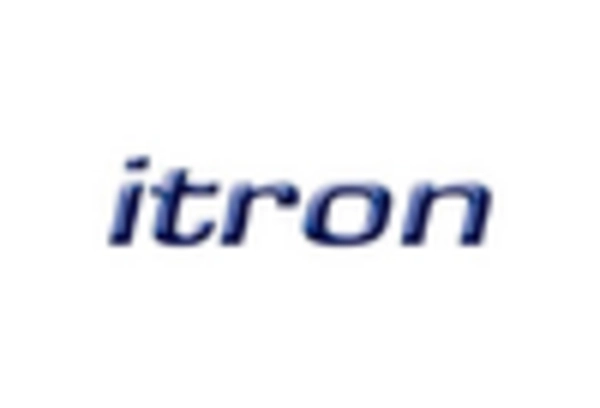Self-Healing Grid Market Technology Insights
The Self-Healing Grid Market within the Technology segment is experiencing significant growth, driven by the increasing need for reliable and efficient energy distribution systems. In 2023, the market was valued at 23.53 USD Billion and is projected to reach 45.8 USD Billion by 2032. A critical aspect of this market is its segmentation, which includes Advanced Metering Infrastructure, Distribution Automation, and Supervisory Control and Data Acquisition, each playing an essential role in enhancing grid resilience and operational efficiency.
Advanced Metering Infrastructure holds a major position in the market, valued at 8.42 USD Billion in 2023 and expected to grow to 16.56 USD Billion by 2032. Its significance stems from the ability to provide real-time data and facilitate demand response programs, leading to smarter grid management. Distribution Automation also commands a noteworthy share, with a valuation of 9.72 USD Billion in 2023, projected to rise to 19.3 USD Billion by 2032. This system streamlines operations, reduces outage times, and improves service reliability, making it a crucial player in the advancement of self-healing grids.
Supervisory Control and Data Acquisition, valued at 5.39 USD Billion in 2023 and set to reach 10.94 USD Billion by 2032, serves as a vital backbone for monitoring and control operations, allowing for the integration of various technologies in grid management. This segmentation reflects the market's emphasis on innovative solutions for grid resilience and highlights key growth drivers such as technological advancements and increasing demand for uninterrupted power supply. Moreover, these segments collectively contribute to the overall market growth by promoting operational efficiency, reducing maintenance costs, and enhancing service quality in the energy sector.
The overall trends indicate a strong shift towards modernization and digitization in the energy distribution landscape, with each segment addressing diverse challenges related to energy delivery and management. This growing focus on self-healing grid technologies is expected to open up new opportunities for providers and stakeholders involved in the Self-Healing Grid Market as the transition towards smarter, more resilient grids continues. Therefore, understanding the Self-Healing Grid Market data and market growth within this Technology segment is vital for stakeholders aiming to capitalize on the evolving landscape and meet the increasing demands for sustainable energy solutions.

Source: Primary Research, Secondary Research, Market Research Future Database and Analyst Review
Self-Healing Grid Market Components Insights
The Self-Healing Grid Market, valued at 23.53 USD Billion in 2023, encompasses a variety of components essential for enhancing the resilience of electrical grids. The segmentation primarily includes Sensors, Software, Communication Technology, and Control Devices, each playing a critical role in improving grid performance and reliability. Sensors are vital for real-time monitoring and data collection, enabling proactive maintenance and rapid response to faults, while Software solutions manage vast datasets to optimize grid operations. Communication Technology facilitates seamless data exchange between various components, ensuring efficient interaction among devices.
Control Devices are crucial for automating processes and ensuring grid stability, thus preventing outages. With the increasing demand for reliable energy systems, growth drivers include advancements in technology and rising investments in grid modernization. However, the market faces challenges like high initial costs and insufficient infrastructure in some regions. Nevertheless, there are significant opportunities for growth, particularly in integrating advanced technologies into existing grid frameworks, which can lead to improved efficiency and sustainability in the Self-Healing Grid Market.
Self-Healing Grid Market Application Insights
The Application segment of the Self-Healing Grid Market plays a critical role in enhancing the efficiency and reliability of electricity distribution. In 2023, this segment contributed significantly to the overall market valuation of 23.53 USD Billion. Key areas within this segment, such as Smart Grid Management, have become increasingly vital as they facilitate real-time monitoring and automated responses to grid disturbances, ensuring minimal downtime and improved resource allocation. Energy Distribution systems are also crucial, providing the backbone for delivering electricity efficiently to consumers while integrating renewable energy sources.
Monitoring and Control applications support these efforts by enabling utilities to detect issues proactively, thereby reducing operational costs and enhancing service reliability. The Self-Healing Grid Market statistics demonstrate a robust growth trajectory, driven by increasing urbanization and the need for sustainable energy solutions, highlighting the importance of these applications in the market growth. As trends shift towards digitalization, these applications are expected to witness substantial advancements, creating numerous opportunities for stakeholders within the industry.
Self-Healing Grid Market End Use Insights
The Self-Healing Grid Market is experiencing significant growth, particularly across its End Use categories, as it sets the stage for a more resilient energy infrastructure. By 2023, the market value reached 23.53 billion USD, reflecting the demand for advanced grid technologies. The residential sector plays a vital role, leveraging smart technologies to enhance energy efficiency and reliability, which adds considerable value to households. The commercial segment is also crucial, as businesses increasingly adopt self-healing grids to minimize downtime and optimize operational costs.
Lastly, the industrial sector’s major holding in this market emphasizes the importance of reliability and maintenance in manufacturing processes. The integration of self-healing capabilities is driving market growth across these categories, showcasing the industry's response to energy demands and environmental regulations. Market trends indicate a growing awareness around energy independence and sustainability, further propelling the Self-Healing Grid Market's statistics as stakeholders seek opportunities to invest in advanced electrical grid technologies.
Additionally, challenges like funding and technology integration must be addressed to fully realize this market's potential in the coming years.



















Leave a Comment